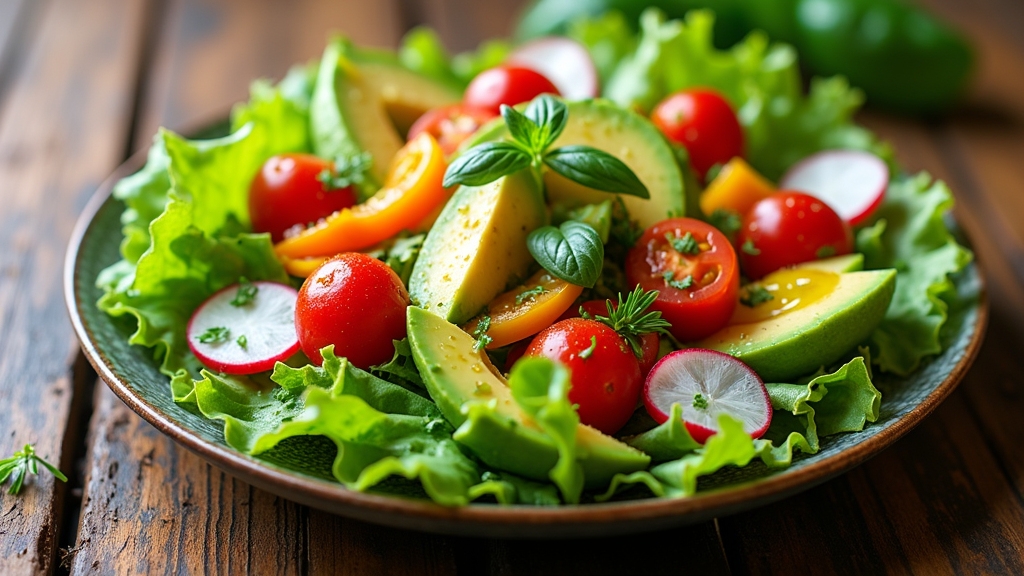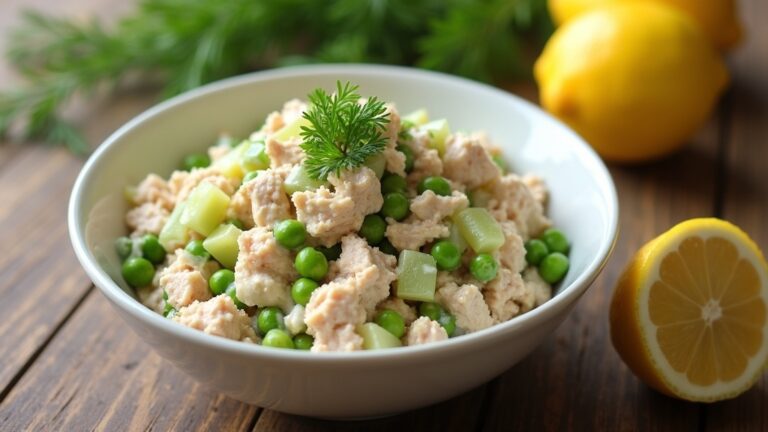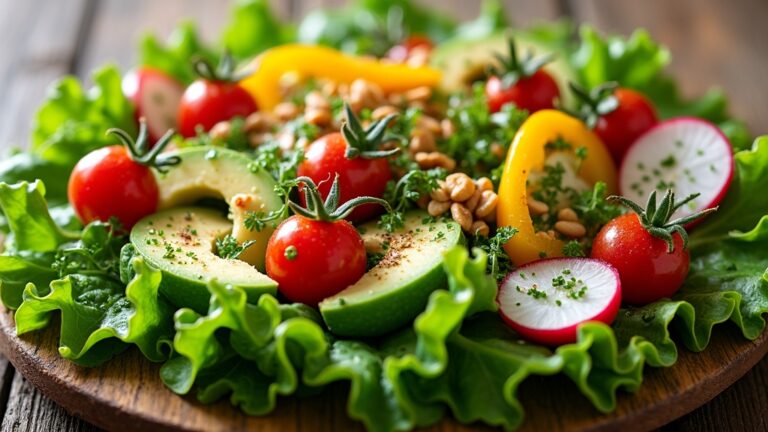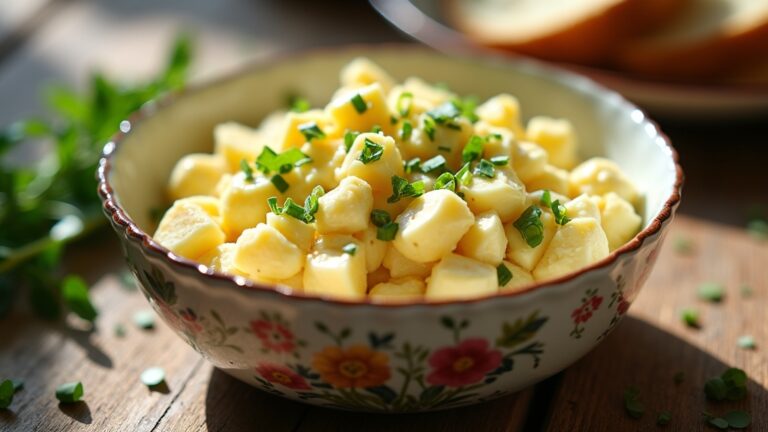Garden Salad Recipe
I love making garden salad since it’s so fresh and vibrant! You just combine mixed greens, cherry tomatoes, cucumber, bell pepper, shredded carrot, and red onion. Toss with your favorite dressing and maybe some feta or olives for added flavor. It’s low in calories and packed with vitamins, making it a healthy choice. The crunch and colors are simply delightful! Trust me, there’s so much more to explore with variations and tips that can elevate your salad game.
Contents
History
When I think about the history of garden salad, I can’t help but appreciate how this simple dish has evolved over centuries. Its roots trace back to ancient agriculture, where early civilizations combined fresh greens with local herbs and vegetables. This mingling of flavors reflected their dietary customs, emphasizing freshness and seasonal availability. As cultures intermingled, so did their salad traditions, leading to innovative combinations that tantalized taste buds. From the rustic gardens of Rome to today’s gourmet creations, salads have transformed dramatically. Each iteration tells a story of culinary evolution, where the freshness of ingredients remains central. Today, I find inspiration in the past as I explore new ways to elevate this timeless dish, keeping its rich history alive.
Recipe
A garden salad is a fresh and vibrant dish that brings together a variety of vegetables, making it the perfect accompaniment to any meal or a light meal on its own. This salad is not only easy to prepare but also customizable, allowing you to use seasonal vegetables and your favorite toppings. The crunch of fresh veggies combined with a tangy dressing creates a delightful explosion of flavors that will excite your palate.
To create a garden salad, you will need a mix of fresh greens and colorful vegetables. The beauty of this dish lies in its simplicity and the freshness of its ingredients. You can experiment with different textures and flavors by adding nuts, seeds, or even cheese if you desire. Whether served at a barbecue, a picnic, or as part of a dinner, a garden salad is sure to impress your guests and keep everyone coming back for more.
A garden salad combines fresh greens and vibrant vegetables, offering a simple yet delightful way to impress at any gathering.
Ingredients:
- 4 cups mixed salad greens (e.g., romaine, spinach, arugula)
- 1 cup cherry tomatoes, halved
- 1 cucumber, diced
- 1 bell pepper, diced (any color)
- 1 carrot, shredded
- 1/4 red onion, thinly sliced
- 1/2 cup radishes, sliced
- 1/4 cup olives (optional)
- 1/4 cup feta cheese or shredded cheese (optional)
- 1/4 cup salad dressing of your choice (e.g., balsamic vinaigrette, ranch, or olive oil and vinegar)
- Salt and pepper to taste
In a large salad bowl, combine the mixed salad greens, cherry tomatoes, cucumber, bell pepper, carrot, red onion, and radishes. If you’re using olives or cheese, add them to the bowl as well. Drizzle your salad dressing over the top and toss gently to combine all the ingredients, ensuring everything is evenly coated. Taste and season with salt and pepper to your liking, then serve immediately for the freshest flavor.
For best results, always use fresh, high-quality ingredients. Letting the salad sit for a few minutes after tossing allows the flavors to meld together, but be cautious with the dressing; if you let it sit too long, the greens may wilt. You can also prepare the ingredients ahead of time and store them separately in the refrigerator. Just toss everything together and dress it right before serving for the best crunch and flavor!
Cooking Steps
Now that we have our fresh ingredients ready, let’s jump into the cooking steps that make this garden salad come alive. I’ll guide you through washing and chopping the vegetables, adding the perfect dressing, and finishing it off with a sprinkle of cheese or nuts. Trust me, these simple steps will elevate your salad to a whole new level of deliciousness!
Step 1. Wash and Chop Vegetables
Start by rinsing your vegetables under cool, running water to remove any dirt and pesticides. This essential vegetable washing step guarantees you’re starting with clean, fresh produce. Once they’re washed, it’s time to chop! I love experimenting with different chopping techniques to create visual appeal and texture in my salad. Here are a few tips:
- Dice: For small, uniform pieces that blend well with other ingredients.
- Julienne: Thin strips that add elegance and crunch.
- Rough chop: For a rustic, hearty feel that showcases freshness.
As I chop, I focus on keeping my knife sharp and my cuts even for a professional finish. These methods not only enhance flavor but also elevate the overall presentation of my garden salad. Enjoy!
Step 2. Add Dressing and Toss
Once you’ve prepped your fresh vegetables, it’s time to bring everything together with a delicious dressing. I love experimenting with various dressing types, from zesty vinaigrettes to creamy ranch, to elevate the flavors. Pour your chosen dressing over the salad, starting with a modest amount—remember, you can always add more if needed! Now, let’s talk tossing techniques. I prefer using a gentle folding motion, ensuring each piece of veggie gets coated without bruising them. This delicate method helps maintain the crunch while blending all those vibrant flavors. As I toss, I can’t help but admire the colors coming together—it’s a feast for the eyes! Enjoy the process, and soon you’ll have a stunning salad ready to impress.
Step 3. Add Cheese or Nuts
To elevate your salad even further, adding cheese or nuts can introduce delightful textures and flavors. Cheese varieties like feta, goat cheese, or parmesan can add creaminess and a salty edge that complements fresh veggies perfectly. On the other hand, nuts bring a satisfying crunch while also boosting the nutritional profile of your dish. Here are some options to contemplate:
- Cheese Varieties: Feta crumbles for tanginess, shredded parmesan for nuttiness, or creamy goat cheese for richness.
- Nut Benefits: Almonds for protein, walnuts for omega-3 fatty acids, or pecans for a sweet touch.
Experimenting with these additions can transform a simple garden salad into a gourmet experience that’s both nourishing and exciting. Enjoy your innovative creation!
Step 4. Garnish With Fresh Herbs
As I prepare to plate my garden salad, I can’t help but think about how fresh herbs can elevate its appeal. Adding a sprinkle of vibrant herb varieties like basil, cilantro, or dill not only enhances the visual appeal but also brings an explosion of flavor enhancement. I love tearing basil leaves into small pieces, allowing their aromatic essence to mingle with the crisp vegetables. Cilantro adds a revitalizing zest, while dill introduces a unique tang. Each herb contributes its own personality, transforming a simple salad into a culinary masterpiece. Don’t shy away from experimenting—mix and match these herbs to discover combinations that excite your palate. A few fresh herbs can truly make all the difference!
Step 5. Serve Immediately
While the ingredients of your garden salad are still crisp and vibrant, it’s crucial to serve it immediately. The freshness importance cannot be overstated; once the veggies start to wilt, you lose that delightful crunch and flavor. I love plating my salad right after tossing it, ensuring the colors and textures shine.
Here’s why serving right away is key:
- Crispness: Enjoy the satisfying crunch of fresh vegetables.
- Flavor: The dressing enhances the salad’s taste when it hasn’t had time to soak in.
- Visual Appeal: A freshly served salad is more inviting and appetizing.
Nutritional Guide
A colorful garden salad isn’t just a feast for the eyes; it’s also packed with essential nutrients that can elevate your health. When I indulge in this vibrant dish, I appreciate its low caloric content and the impressive vitamin benefits it provides. Each ingredient contributes to my well-being, making it a guilt-free choice.
Here’s a quick nutritional overview:
| Nutrients | Amount per Serving |
|---|---|
| Calories | 150 |
| Vitamin A | 80% DV |
| Vitamin C | 60% DV |
| Fiber | 4g |
With every bite, I’m nourishing my body while enjoying delightful flavors. So, let’s embrace this invigorating option and make our meals both delectable and nutritious!
Final Thoughts
Reflecting on my experience with this garden salad, it’s clear that incorporating vibrant, fresh ingredients not only enhances our meals but also our health. Using seasonal ingredients can transform a simple dish into a culinary masterpiece. I’ve enjoyed experimenting with flavor variations that excite the palate and inspire creativity in the kitchen.
Incorporating vibrant, fresh ingredients into our meals not only boosts flavor but also enhances our health and creativity in the kitchen.
Here are a few ideas to elevate your garden salad:
- Mix different greens: Try arugula, spinach, or kale for diverse textures.
- Add unexpected fruits: Consider berries or citrus for a burst of sweetness.
- Incorporate unique dressings: Homemade vinaigrettes with herbs can elevate the entire dish.
Frequently Asked Questions
Can I Add Fruits to My Garden Salad?
I love adding fruits to my salads. The vibrant fruit combinations create delightful flavors and enhance salad textures. Think juicy strawberries or crisp apples—together, they transform a simple dish into a revitalizing, innovative delight!
What Dressing Pairs Best With a Garden Salad?
Imagine a painter blending colors; that’s how I see dressing varieties complementing my salad. A zesty vinaigrette achieves flavor balance, while creamy dressings add richness. Experimenting with both opens a world of delicious possibilities!
How Long Can a Garden Salad Last in the Fridge?
I’ve found that a well-stored salad lasts about three to five days in the fridge. To maximize its lifespan, I keep the dressing separate, ensuring freshness and crunch in every bite. Enjoy your salad storage!
Are There Any Common Allergies Associated With Garden Salad Ingredients?
Did you know about 2% of adults have food allergies? Common allergens in salads include nuts and dairy. I often make ingredient substitutions, like using seeds instead, to create delicious, allergy-friendly options that everyone can enjoy!
Can I Serve Garden Salad as a Main Dish?
Absolutely, I often serve garden salad as a main dish! Just adjust your serving sizes and add hearty ingredients, like proteins or grains, to create a satisfying meal that’s both vibrant and innovative. Enjoy experimenting!
Conclusion
In the end, making a garden salad is about embracing fresh flavors, celebrating vibrant colors, and nourishing our bodies. As we toss together crisp greens, juicy tomatoes, and crunchy cucumbers, we create not just a dish, but a delightful experience. Each bite bursts with life, reminding us of nature’s bounty and the joy of simple ingredients. So, let’s gather our veggies, share our creations, and savor the moments that make our meals truly special. Happy salad-making!








